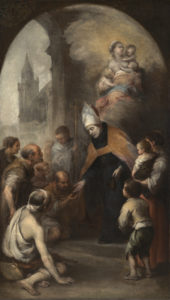“All Consuming: Art and the Essence of Food,” a current exhibit at Pasadena’s Norton Simon Museum, features 60 paintings, prints, photographs, and sculptures spanning the years 1500-1900. How did artists during those four centuries respond to and shape food cultures?
In the first two galleries, food-based art is addressed through the themes of “Hunger,” “Excess,” and “Sustenance.” “Hunger” explores various facets of food deprivation. “Excess” features opulence and eroticism around food. “Sustenance” regards food through the lens of agricultural landscapes, labor, and commerce.
The idea is to present actions and dynamics that give food profound social meaning.
“Excess,” for example, “explores depictions of morally questionable consumption, which were shaped by historically specific attitudes about gender, class, and race.”
I perused the works with an eye toward curiosity and enjoyment, rather than trying to imbue them with identity politics, and thoroughly enjoyed the range of styles, eras, and attitudes toward the production and consumption of food.
“Saint Thomas of Villanueva Giving Alms to the Poor” (1665-1670), by the Spanish painter Bartolomé-Esteban Murillo, depicts the Augustinian friar piously distributing coins to the hungry while an angelic mother figure hovers above.

Other more raucous scenes from that time show the ways those coins may have been spent: Adriaen van Ostade’s “Carousing Peasants,” Rembrandt’s “The Pancake Woman,” Jan Steen’s “Wine is a Mocker,” and William Hogarth’s satirical “Gin Lane,” in which an inebriated female with sores on her legs swills from a bottle as her neglected tot hurtles headlong over the banister of a steep set of steps.
On the other end of the spectrum, 17th-century Dutch and Flemish paintings depict almost insanely sybaritic opulence. In Frans Snyders’ 8½-foot-wide “Still Life with Fruit and Vegetables,” (1625-1635), wicker baskets are piled high, bowls burst, and platters flow over with grapes, figs, peaches, cherries, melons, plums, and chestnuts. That all this bounty would not have ripened in a single season only adds to the sense of extravagance.
“Young Girl Holding a Basket of Fruit,” a mid-18th-century piece by François-Hubert Drouais, spells out the metaphor. One breast provocatively exposed, the girl in question holds up a bunch of dewy grapes, her expression telegraphing that there’s fruit — and then there’s fruit.
“The Poultry Market at Pontoise” (1882) by Camille Pissarro, presented as a protest against capitalism and mass production, struck me instead as a celebration of earthy, vivid agrarian life.
The peasant seller, clearly in her element, stands hand casually on hip, the doyenne of her wares, while an elegantly dressed urban shopper shyly eyes the chickens and eggs. That’s just how I feel 150 years later at, say, the Sunday morning Hollywood Farmers Market: grateful to and slightly in awe of the people who live with their hands in the dirt.
The third gallery features photographs by Edward Weston (American, 1886-1958) and Manuel Álvarez Bravo (Mexican, 1902-2002).
Weston’s vineyards and ranches depict the vast sweep of California food production. In “Lettuce Ranch, Salinas Valley” (1935), row upon row of plowed and planted earth form a telescoped triangle converging toward the apex in a grouping of farmhouses and shade trees. A cloudless sky looms above. Mountains shimmer in the distance. The scene is eerily devoid of humans: the legions of workers who dig, plant, harvest, and the owners who reap the monetary rewards.
Álvarez Bravo, by contrast, is known for his photographs of Mexican street life, including day-to-day encounters with food and drink. “The countryside, the daily life of the street is so much richer than doing portraits, than doing nudes,” he observed.
In “Los agachados” (“The Crouched Ones,” 1934), five working-class men, back to the camera, sit on stools wolfing down their lunch beneath the half-closed metal shutter of a mom-and-pop café. One wears paint-splattered overalls, another cradles a beat-up shoeshine box between his feet. The stools are chained together and to the counter. The men’s anonymous shoulders and heads are shrouded in shadow. They could almost be kneeling at the Communion rail.
This is how those who work with their hands eat: hurriedly, almost furtively, forever poised to bolt. The artist explained the piece’s title by noting that his fellow country people “can fold their body and soul into this humble position and still retain their pride and integrity.”
Looking at the photo again, I thought of my late father, a New Hampshire bricklayer with eight kids who went off to work every morning with a battered red-and-white Igloo cooler. Thus he might have crouched on a half-finished wall over his bologna sandwich lunch or sat on a barstool for a quick beer with the guys after work before coming home to … us.
If I were to play “Separated at Birth” with the pieces in the exhibit, I’d pair “Los agachados” with a dreamy 1650s oil painting by Aelbert Cuyp (Dutch) called “Evening in the Meadows,” in which a sturdy peasant maiden, also with her back to the viewer, crouches to milk a cow.
I don’t see the people who make our lives possible — those who pick the broccoli, build the houses, tend the yards — as victims. I bow before them.

